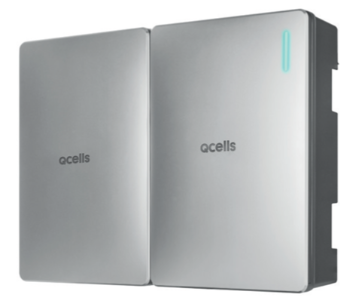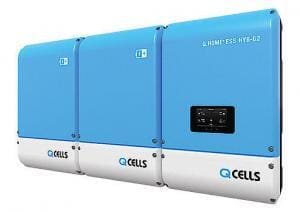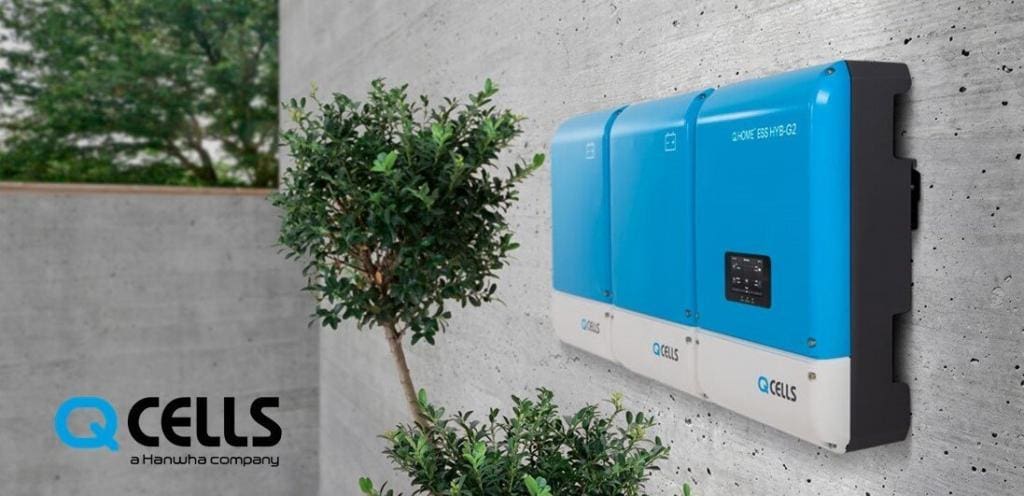Background on Hanwha Q CELLS – Company History
Q Cells Battery Options
Q. Home Core

The Q. Home Core series, launched in Australia since 2022 with 2 products: Q. Home Core A5 and Q. Home Core H5. Both variants incorporate Samsung SDI lithium-ion NCA battery cells for safe and reliable battery performance.
The Q. Home Core A5 is designed for existing solar systems, using an AC-coupled design. The Q. Home Core H5 is DC-coupled and is suitable for new solar and battery installations.
The Q. Home Core series is modular and scalable, with each module featuring 6.8 kWh of storage capacity. With the potential of combining up to 3 units, this means users can choose from 6.8kWh, 13.6kWh or 20.4kWh. These are larger modules sizes that some battery competitors so the size options are a little limited for the Q. Home Core series.
The Core series has a rated depth of discharge of 95%, which means of their 6.8kWh capacity rating, only 6.51kWh is usable. This depth of discharge rate is competitive with alternate options on the market, with only a few batteries offering 100%.
That battery is rated with an environmental protection of IP65 which means you can install this system outdoors. It would be important to keep the system out of direct sunlight and rainfall if possible to maximise the longevity and performance of the battery.

Q. Home ESS HYB-G2
The Q. Home ESS HYB-G2 is effectively a hybrid solar inverter and a battery storage system paired together in an all in one unit. Effectively, now customers can buy an entire solar and battery system that is Q Cells branded which they argue provides one point of contact for technical and warranty support.
Currently the system is only available with a common 5kW hybrid inverter which has a maximum input of 6.6kW’s of DC power (solar panel capacity). The battery however is scalable in 4kWh units with as many as three units being able to be combined into the same system reaching a maximum battery potential of 12kWh’s. This will meet the needs of most residential applications in Australia, but if you want to install more than 6.6kW of solar panels then you will have to look elsewhere.
The Q. Home solution utilises a Samsung lithium iron phosphate battery, which is commonly used by renewable energy manufacturers due to its comparatively safe characteristics. The solution comes with a 10 year warranty which provides piece of mind and is backed by a large South Korean company.
The accompanying web monitoring provides installers and customers with all the necessary information on the performance and efficiency of the solar system. The system will require a ethernet internet connection and provides a cloud-based monitoring tool through a web application and a mobile app.
The hardware is IP65 rated as “dust tight” which means it would survive being sprayed by a hose pipe and is therefore suitable for installation indoors or outdoors. If outdoors, it would be important to keep the inverter and batteries out of direct sunlight to improve performance and life expectancy.
Q Cells Batteries – Key features and points of difference
Beyond the sleek appearance of the product, there are a number of features of Q.Home ESS HYB-G2 worth mentioning:
15-year Product Warranty
The Q Cells Q. Home Core series batteries come with an industry leading 15-year product warranty. As batteries typically have a long payback period, this provides greater certainty to customer of a positive financial outcome.
The older Q. Home ESS HYB-G2 model only comes with a 10-year warranty which is the standard for solar batteries in Australia.
High Depth of Discharge (DoD)
Depth of Discharge indicates the percentage of a battery’s energy that has been discharged relative to the overall capacity of the battery. Because the useful life of a battery decreases each time you charge, discharge, and re-charge or cycle your battery, many battery manufacturers specify a maximum DoD level for optimal battery performance. In general, batteries with a higher depth of discharge provide greater utilisation to customers. The Q.HOME Core battery provides a attractive depth of discharge of 95% which matches most of the better quality battery solutions in the market.
Built in Back up Power

The Q Cells batteries feature built in back up power capability which will keep the lights on during a power outage. Some other batteries (like the Tesla Powerwall 2) required the costly installation of additional hardware to enable this capability.
How much do Q Cells batteries cost?
See the below table which provides an indicative guide based on data from Solar Choice’s Battery Price Index on the cost of installing a Q. Home ESS HYB-G2 with different battery capacity:
| Q. Home ESS System | Wholesale Price ($AUD) |
| Q. Home Hybrid 5kW Inverter | $2,599 |
| Q. Home ESS HYB-G2 Battery 4kWh | $3,399 |
Please note
- Prices are recommended wholesaler’s listed price – the final price a customer would pay depends on the installer’s markup and installation costs
- Price estimates does not include any state-based incentives
Compare quotes from up to 7 installers in your area now.
To give this cost context it is important to balance the cost of a battery against the return of a cheaper power bill. Solar Choice’s solar and battery calculator is a comprehensive tool to understand the financial viability – although be warned, we looked at 48 scenarios and couldn’t find anything that made financial sense.
Australian warranty terms for Q Cells batteries
The Q Cells home batteries come with a product warranty and a performance warranty
The product warranty covers and defects in materials and workmanship that have a significantly negative effect on the the product. Q Cells will decide to either repair, replace or compensate the customer for the defective battery.
The Q Cells Q. Home Core series batteries come with a 15-year product warranty while the Q. Home ESS HYB-G2 model only comes with a 10-year warranty.
Pros and Cons of Qcells Battery
- Large solar company with strong financial backing
- 15 years product & performance warranty provided with new Core series
- Have Australian office in North Sydney
- Limited flexibility on system sizing with relatively large module storage capacity
- Q Cells have recently stopped selling solar panels to the Australian market so it is unclear if they will continue the same support for their batteries
Q Cells Q.Home ESS HYB-G2 specifications
Battery Unit:
| Usable Capacity | 4kWh | 8kWh | 12kWh | |||
| Battery Usable Capacity | 3.6kWh | 7.2kWh | 10.8kWh | |||
| Nominal voltage (single phase system) | 230V | |||||
| Operating voltage range (single phase system) | 184 – 264V | |||||
| Battery Cell Technology | Lithium Ion | |||||
| Maximum Charging/Discharging Current | 17 (9.8 with one battery module)/17 | |||||
| Operating Temperature Range | -20 °C to 55 °C | |||||
| Outdoor/Indoor | IP65 | |||||
| Warranty | 10 Years | |||||
Hybrid Inverter Unit:
| Max. Input Voltage [VDC] | 550V | |
| Number of independent MPPTs | 2 | |
| Max. Input Current per MPPT | 15A | |
| Phases | Single | |
| Nominal Output Voltage/Range | 230V/184V~264V | |
| Nominal Current output | 21.7A | |
| Max. Efficiency | 95.28% | |
| Outdoor/Indoor | IP65 | |
| Warranty | 10 Years | |
Read about home battery government schemes across Australia
South Australia, New South Wales, Victoria, and Australian Capital Territory all currently have a home battery scheme in place.
The South Australian Home Battery Scheme enables eligible South Australian residents to receive up to $4,000 per installed battery.
The New South Wales Home Battery Scheme offers an interest-free loan up to $9000 for eligible households looking to install a solar battery.
The Victorian Government under the Solar Homes Program provides to those eligible, a maximum discount of $4,174 off the battery sale price.
The Australian Capital Territory Government under the Next Generation Energy Storage program provides a rebate of $825 per kilowatt (kW). An average household with a 5kW system would be eligible for approximately $4,000.
Read more product reviews from Solar Choice
Since 2008 our knowledge and sophisticated software has allowed over 300,000 Australian households and businesses to make a well-informed choice on their solar & battery installer.
- Solar Panel Costs: Solar Choice Price Index | April 2025 - 1 April, 2025
- Solar Panels For Homes – All You Need to Know About Solar Systems - 18 March, 2025
- Best NSW Solar Feed-In Tariffs - 17 March, 2025
Reviews from Australians who have installed Q Cells Batteries
Review left 2 years after system installed
Performance is as expected. Only downside is Qcells are no longer available in Australia
Still waiting to get the full experience but it doesn't look like there is an option to charge the Battery from grid during off-peak when you know that the battery will not fully charge during the day (rainy/cloudy). The existing Solar AC input doesn't go to the Inverter but connects up through a smart meter that also has the Grid connection and needs another smart meter installed to allow the whole solution to be monitored as my current Growatt inverters (less than 3 years old) can't be integrated into the QHome system.
Review left 2 years after system installed
Great at night and during power outage(s)
Review left 9 years after system installed
So far so good.
System works perfectly


